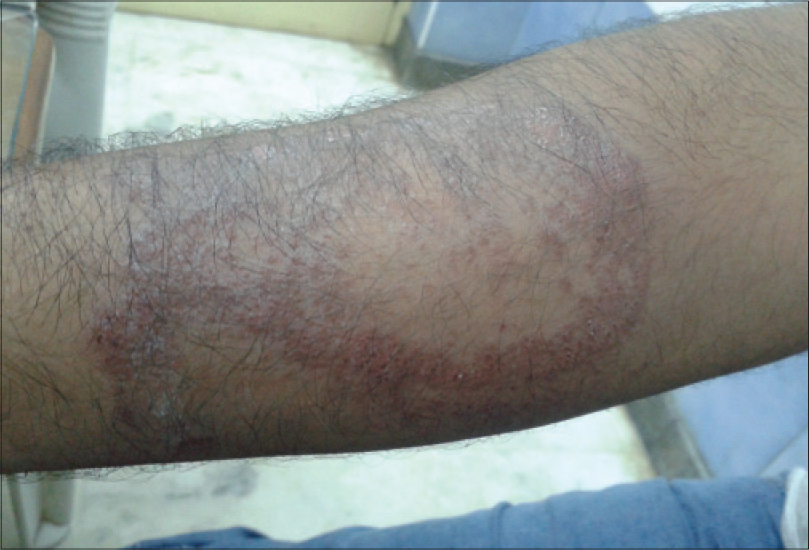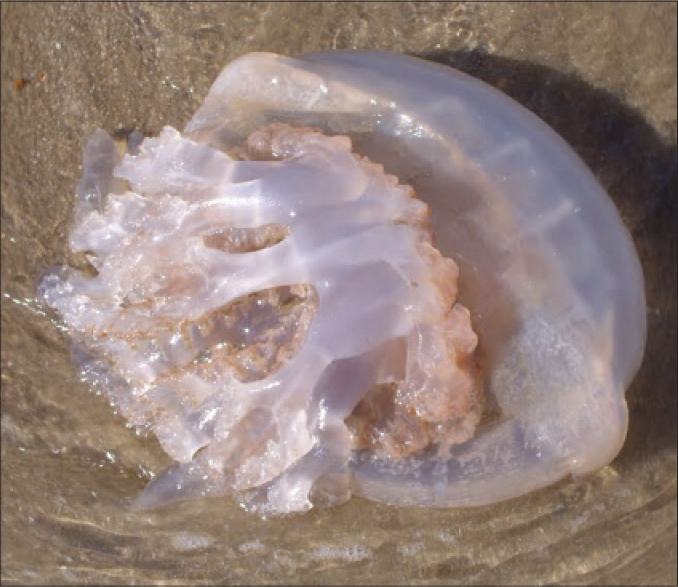Translate this page into:
Jellyfish dermatitis
Correspondence Address:
Karthika Sivaprakasam
9, Thirumalaisamy Street, Namakkal - 637001, Tamil Nadu
India
| How to cite this article: Sivaprakasam K. Jellyfish dermatitis. Indian J Dermatol Venereol Leprol 2015;81:389-390 |
Sir,
A 30-year-old male patient presented with complaints of intense itching over his right forearm for the past 2 days which he attributed to seafood intake. He reported contact with an unidentified marine creature over the forearm and development of a painful erythematous skin rash preceded by a sudden stinging sensation 10 days ago while sea bathing. He also noted the development of palpitations, giddiness, severe myalgia and insomnia later that night. He was treated at a local hospital for jellyfish sting.
On examination, a large bizarre rash studded with erythematous monomorphic papules and mild scaling were seen over the inner aspect of his right forearm [Figure - 1]. Mild tenderness was elicited over the rash. He was prescribed topical corticosteroid cream and oral antihistamines and was asked to avoid seafood. The patient did not consent to a biopsy and could not be followed up for recurrences as he was working ouside the country.
 |
| Figure 1: Jellyfish dermatitis with erythematous, monomorphic papules and mild scaling |
Jellyfish are gelatinous zooplankton coelenterates of the phylum Cnidaria [Figure - 2]. They are also known as free swimming medusae as they have a bell-shaped body with tentacles. These tentacles bear nematocysts or stinging cells that are used for defense and catching prey. Each nematocyst or cnidoblast contains venom carrying coiled threads which on contact with prey or human skin gets uncoiled and ejects venom forcibly . Envenomation from the discharged nematocyst is called jellyfish sting. [1],[2] Immediate reactions include severe pain, local erythema, edema, pruritus, paraesthesia and even hemorrhagic blisters. [2] Delayed cutaneous reactions present as mild pruritic papules and have the histological appearance of allergic contact dermatitis. Lichen planus-like eruptions have also been reported. [3] Sometimes, recurrent or persistent dermatitis may occur.
 |
| Figure 2: Beached jellyfish with bell-shaped body and tentacles |
Secondary reactivation may be related to high anti-jellyfish immunoglobulin levels, intracutaneously sequestered antigen, or cross reacting venom. [4]
If the jellyfish is of a dangerous variety (Indo-Pacific box jellyfish) or if the victim is exposed to a large amount of nematocysts, systemic manifestations like shock, angioedema, dizziness and muscle spasms can occur, with risk of drowning. A less common but serious complication of stings over the extremities is peripheral arterial spasm and compartment syndrome threatening limb viability.
First aid for jellyfish sting includes immediately getting the victim out of the sea and washing the affected area with sea water to remove tentacles. Soaking the affected area in hot water (40°C) will denature the nematocyst and its venom. Topical ice packs and vinegar have also been recommended as first aid for pain relief. Topical corticosteroid and antihistamine drugs can be used for immediate and delayed cutaneous reactions. Topical calcineurin inhibitors help treat recurrent skin reactions. In high risk seaside areas, tropical and jellyfish sting inhibitor lotions and sunscreens are available as over-the-counter products. [2]
All over the world, including the Indian coastline areas, there has been a steady surge in jellyfish population. Recent evidence suggests that these explosive jelly fish blooms maybe due to the effects of human activities such as overfishing, global warming, pollution and coastal development projects leading to degradation of the marine environment. Economic boom, globalization and improved tourism have increased the incidence of jellyfish stings among unsuspecting globe-trotting tourists. Hence jellyfish stings and their sequele are no longer limited to a particular geographic area.
Dermatologists should be aware of the increasing menace of jellyfish stings and their treatment. [5] Delayed allergic cutaneous reactions or jellyfish dermatitis pose a great problem for the victim and the dermatologist as there are high chances of recurrences. Cross reactions of seafood and other factors aggravating jellyfish dermatitis need further studies.
| 1. |
Burns DA. Other noxious or venomous invertebrates. In: Burns T, Breathnach S, Cox N, Griffith C, Editors. Rook ′s Textbook of Dermatology, 8 th ed. Oxford: Blackwell Publishing Ltd; 2010. p. 38, 55-9.
[Google Scholar]
|
| 2. |
Ng SC, Cheng TS. Swimmer′s dermatoses. Hong Kong J. Dermatol Venereol 2013;21:15-21.
[Google Scholar]
|
| 3. |
O′Donnell BF, Tan CY. Persistant contact dermatitis from jellyfish sting. Contact Dermatitis 1993;28:112-3.
[Google Scholar]
|
| 4. |
Loredana Asztalos M, Rubin AI, Elenitsas R, Groft MacFarlane C, Castelo-Soccio L. Recurrent dermatitis and dermal hypersensitivity following a jellyfish sting: A case report and review of literature. Pediatric Dermatol 2014;31:217-9.
[Google Scholar]
|
| 5. |
Brotz L, Cheung WWL, Kleisner K, Pakhomov E, Pauly D. Increasing jelly fish population: Trends in Large Marine Ecosystem Hydrobiologica 2012;690:3-20.
[Google Scholar]
|
Fulltext Views
10,171
PDF downloads
2,339





